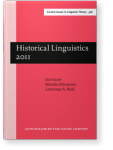Reconstructing the category of “associated motion” in Tacanan languages (Amazonian Bolivia and Peru)
This paper deals with the diachrony of the associated motion (AM) category in the Tacanan languages of the Amazonian lowlands of Bolivia and Peru. The category of AM consists of grammatical markers that attach to non-motion verbs and specify that the verb action (V) occurs against the background of a motion event (e.g., ‘go and V’, ‘V while going’, etc.). The AM systems of Tacanan languages are noteworthy for their remarkably high degree of complexity, reaching levels rarely found in languages of other parts of the word. This raises several questions, one of which is how they evolved historically. In this paper, I gather for the first time the information available on the AM systems of the five Tacanan languages (Araona, Cavineña, Ese Ejja, Reyesano and Tacana) and attempt to reconstruct their past. I first argue that between one and four AM markers can be reconstructed in Proto-Tacanan. Secondly, I argue that several AM markers that are not reconstructible have developed recently out of independent verbs of motion and I make the hypothesis that these have been directly copied into already well established AM paradigms.
Cited by (3)
Cited by three other publications
This list is based on CrossRef data as of 26 july 2024. Please note that it may not be complete. Sources presented here have been supplied by the respective publishers.
Any errors therein should be reported to them.
